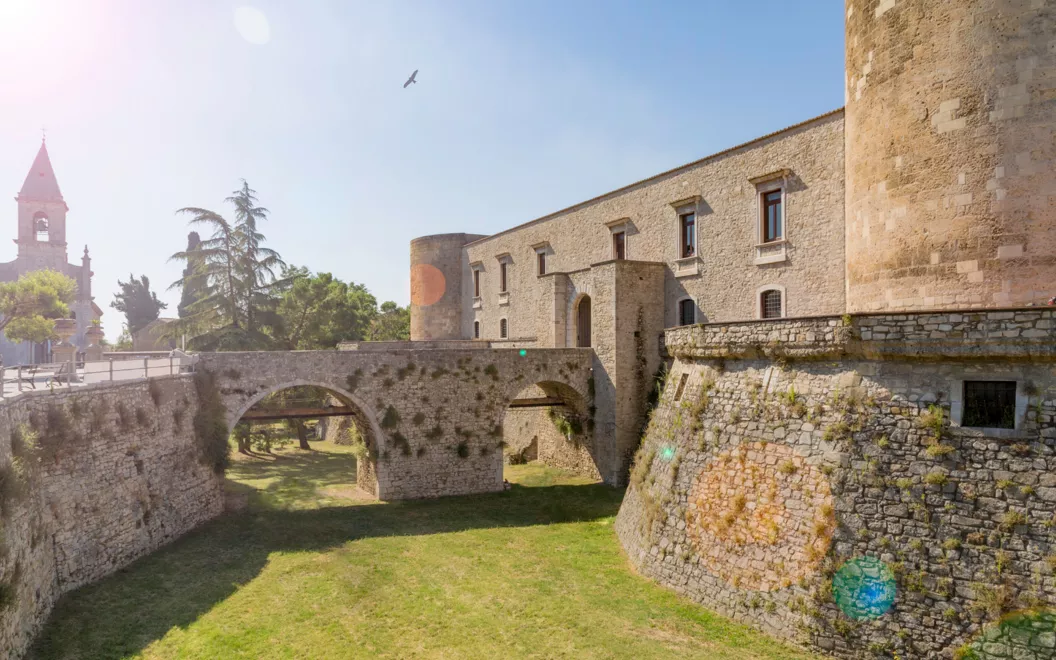Fourth stage of the Giro d'Italia 2023: from Venosa to Lago Laceno
4 minutes
The fourth stage of the Giro d'Italia 2023 starts from Venosa, a small but notable municipality in the province of Potenza, known for being the birthplace of the illustrious Latin poet Horace (1st century BC). On Tuesday, 9 May, the racers will compete on the heights of Monte Vulture that descend towards the Ofanto Valley.
Located on a plateau between two valleys, surrounded by lush nature and the guardian of many historical, artistic and cultural treasures, Venosa is among the most beautiful villages in Italy.
Archaeological findings attest that it has been inhabited since prehistoric times. The site of Notarchirico, with the fossil remains of extinct animals, is the oldest in the Region. The town became a Roman colony in 291 BC, with the name of Venusia, in honour of Venus, the goddess of love. With the fall of the Roman Empire, it was subject to numerous barbarian occupations. In 842 AD, it was sacked by the Saracens, who were driven out by Ludovico II. After the Carolingians, the Swabians reigned and, during the Renaissance, it was under the lordship of the Orsini, then of the Angevins, of the Aragonese, and in the eighteenth century, it was a fief of numerous noble families
Numerous interesting traces of its rich history remain, particularly from the prestigious Roman period. The Archaeological Park preserves the monumental remains of a thermal bath system dating from the 1st to the 3rd century AD, with the domus with a splendid mosaic that is well preserved, and the remains of the first early Christian basilica, among the most important monuments of southern Italy. The complex of the Holy Trinity, recognised in 1897 as a national monument, includes two buildings: the ancient, early Christian church, restored by the Lombards (6th century AD) and the Normans (11th century AD), which preserves the tomb of Altavilla and Alberada, the repudiated wife of Robert Guiscard, and the new church, whose construction began between the 11th and 12th centuries AD, in the Norman period, consecrated in 1059 by Pope Nicholas II, was then enlarged by the Benedictine monks, but was never completed.
In the centre of Venosa stands the imposing Aragonese Castle, a typical example of a medieval fortress with a square plan, with the classic four cylindrical towers and drawbridge, surrounded by a deep moat. It was built in the 15th century AD on a Roman site of cisterns by Duke Pirro del Balzo, whose coat of arms still stands on the west tower, also using material from the Roman amphitheatre. In the basement of the castle, there is the National Archaeological Museum, where there are, among other things, stone slabs with inscriptions in Hebrew, dated between the fourth and ninth century AD, which bear witness to a long presence of the Jewish community in the area. Among the works of greatest cultural and tourist interest are the Jewish catacombs, characterised by a dense network of underground tunnels, niches and loculi, dated between the fourth and sixth centuries AD, located a little further north of the centre, on the hill of the Maddalena.
Among the religious monuments, visitors passionate about "mysteries" will certainly not miss the opportunity to be seduced by the Chiesa del Purgatorio ("Church of Purgatory"), also known as San Filippo Neri, of the 17th century AD, which to welcome them, at the entrance, bears an inscription, on the portal, of a verse by the great poet Horace: "Pulvis et umbra" ("Dust and shadow").
The local cuisine gathers all the heritage of the rich ancient traditions of the region, with recipes that date back to the year 35 BC, such as the typical dish of lagane and chickpeas, a durum wheat pasta prepared with legumes and Cruschi peppers. Here a DOC wine is produced, which is considered to be among the most valuable Italian wines, called Aglianico del Vulture. Among the desserts that must be tasted are the dark pizzicannelli made with cacao, almonds, cinnamon, coffee and sugar, or white raffiuoli, with egg glaze and sugar.
Leaving Basilicata, the 'Corsa Rosa' continues in the direction of Lago Laceno (Laceno Lake), in Campania, in the province of Avellino, more than 1,000 metres above sea level, at the foot of Monte Cervialto, in a basin immersed in the green of the Picentini Mountains where the lake is located.
An oasis of rich vegetation of beech, chestnut, oak, linden, pine, alder, and hazelnut, where various breeds of birds and wild animals live, and tourists can find attractions in every season, the most varied activities, both summer and winter, and a variety of hiking trails. Among the most evocative of these is the Tannera River, immersed in the woods, with its small, enchanting waterfalls.
During the winter season, thanks to the ski lifts, you can practice downhill skiing, cross-country skiing, ski-hiking and ski mountaineering. Being able to admire the sea view from the top of the plateau is an unforgettable experience.
To delight the tastebuds, some of the local gastronomic specialities you absolutely must try include: black truffle, porcini mushrooms, pecorino Bagnolese and, in summer, the exquisite forest fruits of Picento.
The stage podium
Chef Enrico Croatti's cod from Moebius to savour Basilicata and Campania
Cod is a food that is common to many regional culinary traditions, which lends itself to being enjoyed at all times and in every season.



